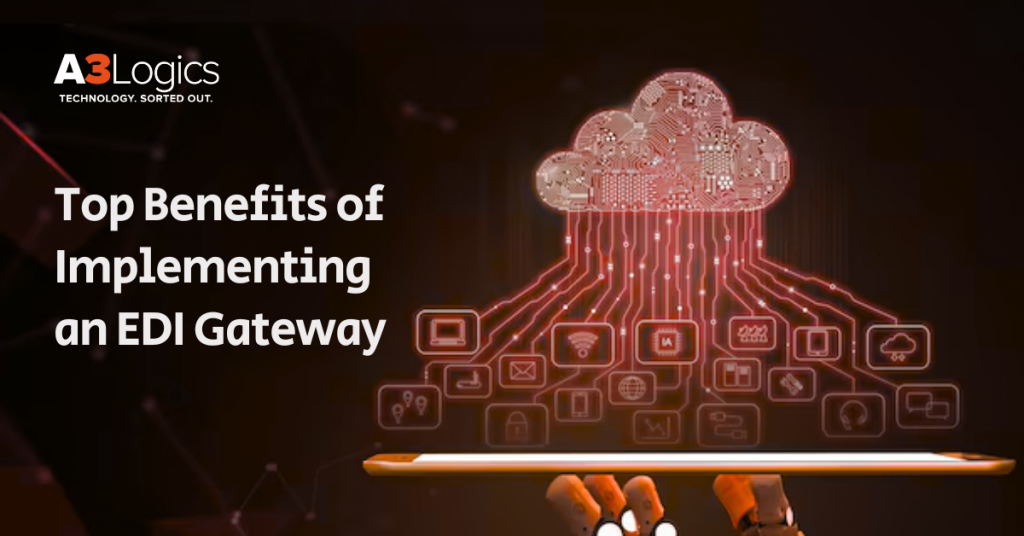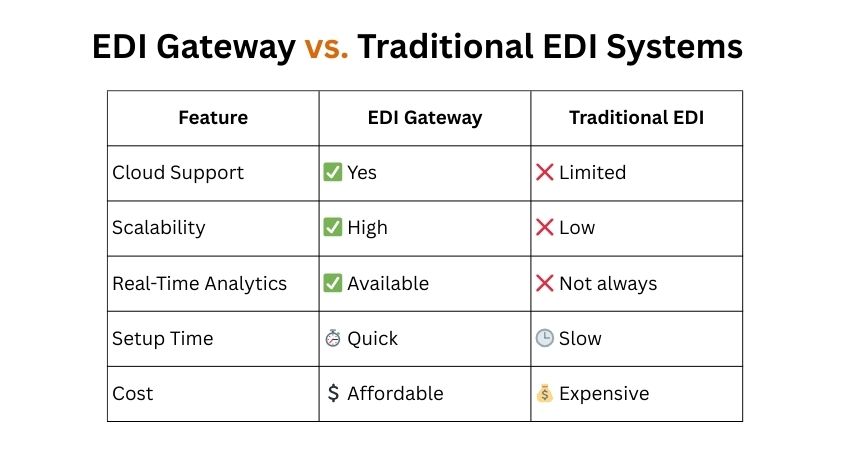As the world is swiftly moving towards digitalization, it is important to keep transactions safe. And, if you are thinking about how you can enhance your chances of achieving the same, then EDI gateway or Electronic Data Interchange gateway has to be the solution. It is one of the best ways to allow businesses to exchange data electronically. In fact, it is done without any access to third parties. You can easily transfer data to suppliers, partners and customers using this tech-facility.
This ease of use has pushed the demand for EDI software high and it can become a $5.1 billion market in 2032. So, if you are thinking about making the most out of it, then you have arrived on the right page. We are here to help you understand all the aspects related to EDI gateway and how it can enhance the process of business transactions.

Table of Contents
What is EDI Gateway and How Does It Work?
The EDI Gateway is revolutionary when compared to its alternatives. It simplifies difficult B2B transactions and helps company scalability by serving as a central hub for managing, translating, and securely delivering EDI documents. The EDI Gateway has grown essential for sectors from healthcare and banking to manufacturing and retail as companies come under more pressure to speed transactions, lower mistakes, and guarantee compliance.
EDI Gateway Definition
A specialized software platform or service known as an EDI Gateway serves as a link between a company’s internal systems and its external trading partners.
Regardless of the formats or protocols used by each party, it automates the conversion, validation, routing, and safe delivery of EDI documents. Centralizing this way simplifies and speeds up the onboarding of new partners and the scaling of operations by removing the need for several, complicated point-to-point integrations.
How Does an EDI Gateway Work?
Designed for efficiency and dependability, the EDI Gateway approach is a multi-layered workflow.
- Data Extraction: The gateway pulls transaction data (such as purchase orders, invoices, or shipping notices) from internal systems like ERP, CRM, or warehouse management.
- Data Translation: It converts data from the company’s proprietary format into standardized EDI formats (e.g., ANSI X12, EDIFACT), ensuring compatibility with partner systems.
- Protocol Conversion: The gateway supports diverse communication protocols (AS2, SFTP, HTTPS, etc.), enabling secure and reliable document transmission.
- Validation: Before sending, the gateway checks each document for compliance with EDI standards and business rules, minimizing errors and rejections.
- Envelope Creation: EDI envelopes are generated, packaging documents with necessary sender/receiver information for accurate routing.
- Routing and Delivery: The gateway determines the correct recipient and delivers the message, either directly or via a Value Added Network (VAN).
- Security and Monitoring: All transactions are encrypted and logged, with real-time dashboards and alerts for tracking and compliance.
- Inbound Processing: Incoming EDI documents are validated, translated, and integrated into internal systems, enabling end-to-end automation.
This streamlined approach allows businesses to manage high transaction volumes, adapt to changing partner requirements, and maintain robust security and compliance across all exchanges.
Why is EDI Gateway Important for Modern Businesses?
Modern businesses operate in a hyper-connected, fast-paced environment where manual processes are no longer sustainable. The EDI Gateway is vital because it:
- Centralizes B2B Integration: By serving as a single control point for all electronic document exchanges, the gateway reduces complexity, maintenance, and administrative overhead.
- Accelerates Transactions: Automation eliminates manual intervention, reducing transaction times from days to minutes and supporting real-time business operations.
- Ensures Compliance: EDI Gateways enforce industry standards and regulatory requirements, providing detailed audit trails and reducing the risk of costly violations.
- Enables Scalability: As businesses grow, the gateway supports rapid onboarding of new partners and increased document volumes without major infrastructure changes.
- Enhances Security: Advanced encryption, digital signatures, and access controls protect sensitive business data during transmission and storage.
- Supports Globalization: Multi-protocol and multi-format capabilities allow organizations to connect with partners worldwide, regardless of their technical landscape.
In summary, the EDI Gateway is not just a technical tool but a strategic enabler that empowers organizations to operate efficiently, competitively, and securely in the digital age.
Top Benefits of Implementing an EDI Gateway

1. Faster Transaction Processing
Automated workflows reduce manual data entry, accelerating order-to-cash and procure-to-pay cycles. Real-time or near-real-time processing ensures that business-critical information is always current, supporting faster deliveries and improved cash flow.
2. Enhanced Accuracy
By automating data translation and validation, EDI Gateways minimize human errors and ensure that information exchanged is consistent, complete, and compliant with partner requirements. This reduces costly chargebacks, shipment delays, and disputes.
3. Better Compliance
Gateways enforce adherence to industry-specific standards (such as X12, EDIFACT, HIPAA), helping businesses stay compliant with regulatory mandates and partner agreements. Detailed audit logs support regulatory audits and internal controls.
4. Cost Savings
Automation reduces manual labor, paper usage, postage, and error-related costs. The total cost of ownership is often lower compared to legacy or custom-coded systems, and operational savings can be significant.
5. Global Partner Connectivity
Support for multiple EDI formats and communication protocols enables businesses to connect with partners worldwide, regardless of regional standards or technical environments. Flexible onboarding supports business expansion and agility.
6. Scalability
Modern EDI Gateways are designed to grow with your business, supporting increasing transaction volumes and the onboarding of new partners without major infrastructure changes.
Key Functions and Features of an EDI Gateway
1. Data Translation
An EDI Gateway’s data translation function converts business documents from a company’s proprietary internal formats into standardized EDI formats, such as ANSI X12 or EDIFACT, and vice versa. This ensures that diverse systems-regardless of their underlying technology or data structures-can seamlessly exchange information. By automating this process, the gateway eliminates manual re-entry, reduces errors, and accelerates business cycles, making interoperability with a wide range of trading partners possible and efficient.
2. Protocol Conversion
EDI Gateways support multiple secure communication protocols, including AS2, SFTP, HTTPS, and X.400, allowing organizations to connect with any trading partner regardless of their preferred transmission method. This flexibility ensures that documents are transmitted safely and reliably, whether through direct point-to-point connections or mailbox-based Value Added Networks (VANs). Protocol conversion also future-proofs B2B integration by accommodating evolving industry standards and partner requirements.
3. Data Validation
Every document processed by an EDI Gateway undergoes rigorous validation to ensure it complies with both EDI standards and specific business rules set by trading partners. This includes checking the structure, required fields, and data accuracy before transmission. Automated validation prevents the exchange of incomplete or incorrect documents, reduces costly errors, and helps maintain strong business relationships by ensuring that only high-quality, compliant data is shared.
4. Routing and Delivery
The routing and delivery feature intelligently determines the correct recipient for each EDI message, whether it’s a direct connection or via a mailbox system such as a VAN. It manages the flow of documents, ensuring they reach the intended trading partner promptly and securely. This capability is crucial for timely business operations, supporting high transaction volumes and complex supply chain networks without manual intervention.
5. Security
Security is paramount in EDI Gateways, which implement industry-standard encryption, digital signatures, and strict access controls to protect sensitive business data throughout its lifecycle. These measures guard against unauthorized access, tampering, and data breaches during transmission and storage. Robust security protocols not only ensure regulatory compliance but also build trust with trading partners and customers.
6. Monitoring and Reporting
EDI Gateways offer comprehensive monitoring and reporting tools, including real-time dashboards, alerts, and detailed audit logs. These features provide complete visibility into transaction status, performance metrics, and compliance with service level agreements. Monitoring enables proactive issue resolution, while reporting supports regulatory audits and continuous process improvement, ensuring transparency and accountability in all EDI exchanges.
7. Trading Partner Management
Trading partner management simplifies the onboarding, configuration, and ongoing administration of all business partners within the EDI Gateway. It provides tools for maintaining partner profiles, mapping requirements, and communication preferences. This streamlines the expansion of business networks, reduces onboarding time, and ensures consistent, efficient interactions with both new and existing partners, supporting rapid business growth and adaptability.

Key Industries Using EDI Gateway Solutions
1. Healthcare
EDI Gateways automate HIPAA-compliant transactions such as claims, remittance advice, and enrollment. So, EDI Automation in Healthcare reduces administrative costs, speeds up reimbursements, and improves patient care by minimizing delays and errors.
2. Insurance
Gateways streamline policy administration, claims processing, and premium payments, ensuring faster and more accurate service delivery. EDI 834 Services are essential for benefits enrollment and maintenance.
3. Manufacturing
Manufacturers use EDI Gateways to manage orders, inventory, shipping, and invoicing with suppliers and distributors, optimizing supply chain operations and supporting just-in-time manufacturing.
4. Retail & eCommerce
Retailers and eCommerce platforms automate order management, inventory updates, and EDI payments, enabling real-time collaboration with suppliers and logistics partners.
5. Finance & Banking
Financial institutions use EDI Gateways for secure, standardized exchange of payment instructions, remittance advice, and compliance reporting.
6. Logistics & Transportation
Logistics providers automate shipment notifications, freight invoices, and customs documentation, enhancing supply chain visibility and efficiency.
Common Challenges in EDI Gateway Implementation
- Complex Partner Requirements: Different partners may use varying standards and protocols.
- Solution: Choose an EDI Gateway that supports multiple formats and protocols, and offers robust mapping tools.
- Integration with Legacy Systems: Older systems may not be EDI Capable.
- Solution: Use our consulting services to design custom integrations or leverage middleware.
- Data Security Concerns: Sensitive data must be protected.
- Solution: Select a gateway with strong encryption, access controls, and compliance certifications.
- Onboarding New Partners: Manual onboarding can be slow and error-prone.
- Solution: Opt for Gateway EDI solutions with self-service portals and automated onboarding features.
- Scalability Issues: Legacy systems may not handle growing transaction volumes.
- Solution: Implement a scalable, cloud-based EDI Gateway.

Choosing the Right Gateway EDI Provider for Your Business
Below are the steps that you need to follow to choose the right gateway for EDI provider for your business. Check it out.
1. Deployment Flexibility
A strong EDI supplier should provide deployment choices that fit your IT strategy-cloud, on-premises, or hybrid. While on-premises installations provide more control and might fit companies with rigorous compliance requirements, cloud options offer scalability and remote access. Hybrid models let you to balance flexibility, security, and legacy system integration as your company changes by combining the benefits of both.
2. Supported Standards and Protocols
Ensure the provider can handle all necessary EDI and non-EDI formats, such as ANSI X12, EDIFACT, and industry-specific standards. They should also support a wide range of communication protocols like AS2, SFTP, and HTTPS. This versatility is crucial for connecting with diverse trading partners and adapting to new market or regulatory requirements without costly system overhauls.
3. Integration Capabilities
Additionally, look for seamless connectivity with your existing ERP, CRM, WMS, and other enterprise applications. Ideally, the provider should offer prebuilt connectors, APIs, and flexible mapping tools. These, in turn, ensure smooth data flow between systems. As a result, effective integration not only minimizes manual intervention but also reduces errors and, more importantly, supports real-time business processes across your organization.
4. Automation and AI
Modern EDI providers, furthermore, leverage automation and AI to streamline mapping, validation, and partner onboarding. As a result, automated workflows significantly reduce manual tasks, accelerate transaction cycles, and minimize human error. Moreover, AI-driven tools can intelligently detect anomalies, optimize document routing, and adapt to changing business rules—thereby enhancing overall operational efficiency.
5. Security and Compliance
Prioritize providers with robust security measures, including encryption, digital signatures, and multi-factor authentication. They should demonstrate compliance with relevant regulations such as HIPAA, GDPR, or SOX. Regular security audits, detailed access controls, and comprehensive logging ensure your sensitive data is protected and your business remains audit-ready.
6. Support and Consulting
Reliable customer support and access to EDI Consulting Services are essential for smooth implementation and ongoing operation. Look for providers offering 24/7 support, clear service level agreements (SLAs), and dedicated account managers. Expert consulting can help tailor solutions to your business needs and resolve issues quickly, minimizing downtime.
7. Scalability and Performance
Select a vendor whose solutions can expand with your company-supporting rising transaction volumes, new document kinds, and more trading partners without performance deterioration. Flexible pricing strategies and scalable designs provide quick adaptation to market changes and company growth.
Future Trends in Gateway EDI Technology
Below are the trends that is going to make things even more exciting in the world of EDI technology in terms of making payments. Check it out.
1. Cloud-Native EDI Gateways
Cloud-native EDI solutions are being adopted more quickly, providing companies more flexibility, scalability, and cost efficiency. Cloud platforms make it easier to support worldwide operations and interface with other cloud-based business applications by enabling fast deployment, automatic upgrades, and simple access from anywhere.
2. AI-Driven Automation
By automating difficult processes including data mapping, mistake detection, and exception management, artificial intelligence is changing EDI. By means of transaction pattern analysis, issue forecasting, and recommendation of corrective measures, artificial intelligence can minimize human interaction and enhance general data quality and process efficiency.
3. Self-Service Portals
Modern EDI Gateways are progressively providing self-service portals, hence enabling trading partners to control their own onboarding, document exchanges, and compliance obligations. By means of real-time visibility into transaction status, these portals lower administrative load, accelerate partner integration, and improve cooperation.
4. Integration with IoT and Big Data
EDI Gateways are changing to link with big data analytics systems and IoT devices. Real-time data collecting and analysis across the supply chain made possible by this integration enhances visibility, forecasting, and decision-making. Actionable insights help companies to optimize operations and react more rapidly to interruptions.
5. Enhanced Security
EDI Gateways are always enhancing security elements as cyberattacks and more stringent rules call for it. Expect developments in encryption, authentication, and anomaly detection as well as more thorough compliance management systems. These improvements guarantee continuous, compliant corporate operations and protect sensitive data.

The A3Logics Advantage in EDI Gateway Solutions
A3Logics delivers comprehensive EDI Services and EDI integrations. Their solutions are designed to streamline Payments and automate complex workflows. With a focus on innovation, security, and scalability, A3Logics empowers businesses to optimize their B2B operations and stay ahead in a rapidly evolving digital landscape.
Final Thought on EDI Gateway
Hopefully you have got complete clarity about the EDI Gateway and how it is one of the primary aspects of modern business operations. It will help the businesses of all sectors to automate, secure, and scale their B2B transactions in the most proficient manner. The world of digital transformation is accelerating significantly. So, it is important that you invest in a robust Gateway EDI solution that can give you a competitive advantage. All you need to do is to take assistance from experts in the business like A3Logics and it will help you achieve compliance without any hassle. Consult now!





